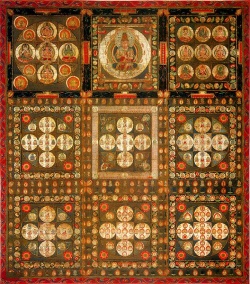Difference between revisions of "Susiddhikara Sutra"
| (One intermediate revision by the same user not shown) | |||
| Line 1: | Line 1: | ||
[[File:Kongokai01.jpg|thumb|250px|]] | [[File:Kongokai01.jpg|thumb|250px|]] | ||
| + | |||
| + | |||
| + | |||
<poem> | <poem> | ||
[[Susiddhikara Sutra]] | [[Susiddhikara Sutra]] | ||
| − | |||
| − | "[[Wonderful Accomplishment Sutra]]." A [[sutra]] of [[Esoteric Buddhism]] translated into Chinese by [[Shanwuwei]] (Skt [[Shubhakarasimha]]) in the eighth century. There are two other Chinese translations. The [[Susiddhikara Sutra]] is one of the three principal scriptures of [[Esoteric Buddhism]], the other two being the [[Mahavairochana]] and [[Diamond Crown sutras]]. In {{Wiki|Japan}}, the [[tradition]] of [[Esoteric Buddhism]] within the [[Tendai]] school affords it particular reverence, while the [[True Word]] ([[Shingon]]) school ranks it below the other two [[sutras]]. The [[Susiddhikara Sutra]] gives detailed instructions on the performance of {{Wiki|incantations}} and {{Wiki|prayers}} directed toward the so-called three divisions, or three groups, of honored ones. These are the [[Buddha]] division, the [[Lotus]] division, and the [[Diamond]] division, symbolizing respectively the [[enlightenment]], [[compassion]], and [[wisdom]] of [[Mahavairochana Buddha]]. The [[sutra]] also divides the purposes of those [[rituals]] into three: {{Wiki|safety}}, the {{Wiki|increase}} of {{Wiki|benefit}}, and the {{Wiki|subjugation}} of [[evil]]. | + | [[蘇悉地経]] (Skt; [[Chin]] [[Su-hsi-ti-ching]]; Jpn [[Soshitsuji-kyo]] ) |
| + | |||
| + | "[[Wonderful Accomplishment Sutra]]." A [[sutra]] of [[Esoteric Buddhism]] translated into {{Wiki|Chinese}} by [[Shanwuwei]] (Skt [[Shubhakarasimha]]) in the eighth century. | ||
| + | |||
| + | There are two other {{Wiki|Chinese}} translations. | ||
| + | |||
| + | The [[Susiddhikara Sutra]] is one of the three [[principal]] [[scriptures]] of [[Esoteric Buddhism]], the other two being the [[Mahavairochana]] and [[Diamond Crown sutras]]. | ||
| + | |||
| + | In {{Wiki|Japan}}, the [[tradition]] of [[Esoteric Buddhism]] within the [[Tendai]] school affords it particular reverence, while the [[True Word]] ([[Shingon]]) school ranks it below the other two [[sutras]]. | ||
| + | |||
| + | The [[Susiddhikara Sutra]] gives detailed instructions on the performance of {{Wiki|incantations}} and {{Wiki|prayers}} directed toward the so-called [[three divisions]], or [[three groups]], of honored ones. | ||
| + | |||
| + | These are the [[Buddha]] [[division]], the [[Lotus]] [[division]], and the [[Diamond]] [[division]], [[symbolizing]] respectively the [[enlightenment]], [[compassion]], and [[wisdom]] of [[Mahavairochana]] [[Buddha]]. | ||
| + | |||
| + | The [[sutra]] also divides the purposes of those [[rituals]] into three: {{Wiki|safety}}, the {{Wiki|increase}} of {{Wiki|benefit}}, and the {{Wiki|subjugation}} of [[evil]]. | ||
</poem> | </poem> | ||
{{R}} | {{R}} | ||
Latest revision as of 03:21, 28 February 2016
Susiddhikara Sutra
蘇悉地経 (Skt; Chin Su-hsi-ti-ching; Jpn Soshitsuji-kyo )
"Wonderful Accomplishment Sutra." A sutra of Esoteric Buddhism translated into Chinese by Shanwuwei (Skt Shubhakarasimha) in the eighth century.
There are two other Chinese translations.
The Susiddhikara Sutra is one of the three principal scriptures of Esoteric Buddhism, the other two being the Mahavairochana and Diamond Crown sutras.
In Japan, the tradition of Esoteric Buddhism within the Tendai school affords it particular reverence, while the True Word (Shingon) school ranks it below the other two sutras.
The Susiddhikara Sutra gives detailed instructions on the performance of incantations and prayers directed toward the so-called three divisions, or three groups, of honored ones.
These are the Buddha division, the Lotus division, and the Diamond division, symbolizing respectively the enlightenment, compassion, and wisdom of Mahavairochana Buddha.
The sutra also divides the purposes of those rituals into three: safety, the increase of benefit, and the subjugation of evil.
